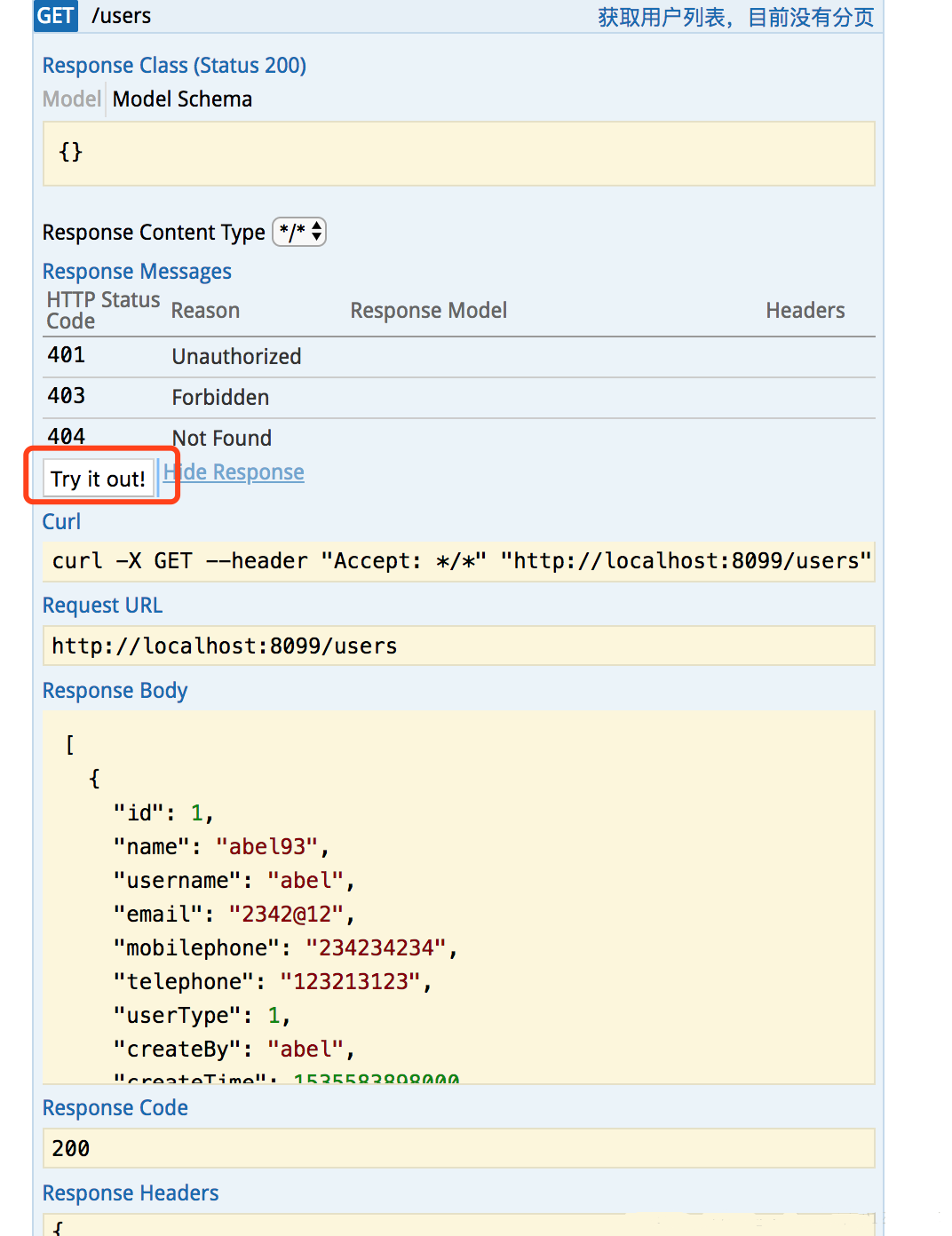您好,登录后才能下订单哦!
这篇文章主要介绍SpringBoot+Swagger-ui如何自动生成API文档,文中介绍的非常详细,具有一定的参考价值,感兴趣的小伙伴们一定要看完!
什么是Swagger
Swagger是一个Restful风格接口的文档在线自动生成和测试的框架
官网:http://swagger.io
官方描述:The World's Most Popular Framework for APIs.
先看一下 swagger-ui 生成的api 的效果吧

然后我们打开查询所有用户的api 看到api 内容

然后在服务器运行的状态下点击 try it out 测试查询功能

接着打开新增的api 查看

好了这个就是自动生成的api 效果。接下来我们就看怎么在我们的项目中使用swagger-ui 吧
springboot 集成 swagger -ui
1、添加依赖
<dependency> <groupId>io.springfox</groupId> <artifactId>springfox-swagger2</artifactId> <version>2.2.2</version> </dependency> <dependency> <groupId>io.springfox</groupId> <artifactId>springfox-swagger-ui</artifactId> <version>2.2.2</version> </dependency>
2、编写配置文件
在application 同级目录新建 Swagger2 文件
package com.abel.example;
import org.springframework.context.annotation.Bean;
import org.springframework.context.annotation.Configuration;
import springfox.documentation.builders.ApiInfoBuilder;
import springfox.documentation.builders.PathSelectors;
import springfox.documentation.builders.RequestHandlerSelectors;
import springfox.documentation.service.ApiInfo;
import springfox.documentation.spi.DocumentationType;
import springfox.documentation.spring.web.plugins.Docket;
import springfox.documentation.swagger2.annotations.EnableSwagger2;
/**
* Created by yangyibo on 2018/9/7.
*/
@Configuration
@EnableSwagger2
public class Swagger2 {
/**
* 创建API应用
* apiInfo() 增加API相关信息
* 通过select()函数返回一个ApiSelectorBuilder实例,用来控制哪些接口暴露给Swagger来展现,
* 本例采用指定扫描的包路径来定义指定要建立API的目录。
* @return
*/
@Bean
public Docket createRestApi() {
return new Docket(DocumentationType.SWAGGER_2)
.apiInfo(apiInfo())
.select()
.apis(RequestHandlerSelectors.basePackage("com.abel.example.controller"))
.paths(PathSelectors.any())
.build();
}
/**
* 创建该API的基本信息(这些基本信息会展现在文档页面中)
* 访问地址:http://项目实际地址/swagger-ui.html
* @return
*/
private ApiInfo apiInfo() {
return new ApiInfoBuilder()
.title("Spring Boot中使用Swagger2构建RESTful APIs")
.description("更多请关注https://blog.csdn.net/u012373815")
.termsOfServiceUrl("https://blog.csdn.net/u012373815")
.contact("abel")
.version("1.0")
.build();
}
}3、在controller上添加注解,自动生成API
注意:
package com.abel.example.controller;
import javax.servlet.http.HttpServletRequest;
import java.util.Map;
import com.abel.example.bean.User;
import io.swagger.annotations.*;
import org.apache.log4j.Logger;
import org.springframework.beans.factory.annotation.Autowired;
import org.springframework.http.HttpStatus;
import org.springframework.http.ResponseEntity;
import org.springframework.stereotype.Controller;
import org.springframework.web.bind.annotation.*;
import com.abel.example.service.UserService;
import com.abel.example.util.CommonUtil;
@Controller
@RequestMapping(value = "/users")
@Api(value = "用户的增删改查")
public class UserController {
@Autowired
private UserService userService;
/**
* 查询所有的用户
* api :localhost:8099/users
* @return
*/
@RequestMapping(method = RequestMethod.GET)
@ResponseBody
@ApiOperation(value = "获取用户列表,目前没有分页")
public ResponseEntity<Object> findAll() {
return new ResponseEntity<>(userService.listUsers(), HttpStatus.OK);
}
/**
* 通过id 查找用户
* api :localhost:8099/users/1
* @param id
* @return
*/
@RequestMapping(value = "/{id}", method = RequestMethod.GET)
@ResponseBody
@ApiOperation(value = "通过id获取用户信息", notes="返回用户信息")
public ResponseEntity<Object> getUserById(@PathVariable Integer id) {
return new ResponseEntity<>(userService.getUserById(Long.valueOf(id)), HttpStatus.OK);
}
/**
* 通过spring data jpa 调用方法
* api :localhost:8099/users/byname?username=xxx
* 通过用户名查找用户
* @param request
* @return
*/
@RequestMapping(value = "/byname", method = RequestMethod.GET)
@ResponseBody
@ApiImplicitParam(paramType = "query",name= "username" ,value = "用户名",dataType = "string")
@ApiOperation(value = "通过用户名获取用户信息", notes="返回用户信息")
public ResponseEntity<Object> getUserByUserName(HttpServletRequest request) {
Map<String, Object> map = CommonUtil.getParameterMap(request);
String username = (String) map.get("username");
return new ResponseEntity<>(userService.getUserByUserName(username), HttpStatus.OK);
}
/**
* 通过spring data jpa 调用方法
* api :localhost:8099/users/byUserNameContain?username=xxx
* 通过用户名模糊查询
* @param request
* @return
*/
@RequestMapping(value = "/byUserNameContain", method = RequestMethod.GET)
@ResponseBody
@ApiImplicitParam(paramType = "query",name= "username" ,value = "用户名",dataType = "string")
@ApiOperation(value = "通过用户名模糊搜索用户信息", notes="返回用户信息")
public ResponseEntity<Object> getUsers(HttpServletRequest request) {
Map<String, Object> map = CommonUtil.getParameterMap(request);
String username = (String) map.get("username");
return new ResponseEntity<>(userService.getByUsernameContaining(username), HttpStatus.OK);
}
/**
* 添加用户啊
* api :localhost:8099/users
* @param user
* @return
*/
@RequestMapping(method = RequestMethod.POST)
@ResponseBody
@ApiModelProperty(value="user",notes = "用户信息的json串")
@ApiOperation(value = "新增用户", notes="返回新增的用户信息")
public ResponseEntity<Object> saveUser(@RequestBody User user) {
return new ResponseEntity<>(userService.saveUser(user), HttpStatus.OK);
}
/**
* 修改用户信息
* api :localhost:8099/users
* @param user
* @return
*/
@RequestMapping(method = RequestMethod.PUT)
@ResponseBody
@ApiModelProperty(value="user",notes = "修改后用户信息的json串")
@ApiOperation(value = "新增用户", notes="返回新增的用户信息")
public ResponseEntity<Object> updateUser(@RequestBody User user) {
return new ResponseEntity<>(userService.updateUser(user), HttpStatus.OK);
}
/**
* 通过ID删除用户
* api :localhost:8099/users/2
* @param id
* @return
*/
@RequestMapping(value = "/{id}", method = RequestMethod.DELETE)
@ResponseBody
@ApiOperation(value = "通过id删除用户信息", notes="返回删除状态1 成功 0 失败")
public ResponseEntity<Object> deleteUser(@PathVariable Integer id) {
return new ResponseEntity<>(userService.removeUser(id.longValue()), HttpStatus.OK);
}
}注解含义:
@Api:用在类上,说明该类的作用。 @ApiOperation:注解来给API增加方法说明。 @ApiImplicitParams : 用在方法上包含一组参数说明。 @ApiImplicitParam:用来注解来给方法入参增加说明。 @ApiResponses:用于表示一组响应 @ApiResponse:用在@ApiResponses中,一般用于表达一个错误的响应信息 code:数字,例如400 message:信息,例如"请求参数没填好" response:抛出异常的类 @ApiModel:描述一个Model的信息(一般用在请求参数无法使用@ApiImplicitParam注解进行描述的时候) @ApiModelProperty:描述一个model的属性
注意:@ApiImplicitParam的参数说明:

paramType会直接影响程序的运行期,如果paramType与方法参数获取使用的注解不一致,会直接影响到参数的接收。
4、启动项目效果图:
服务器启动后访问 http://localhost:8099/swagger-ui.html 效果如下

点击查看效果

以上是“SpringBoot+Swagger-ui如何自动生成API文档”这篇文章的所有内容,感谢各位的阅读!希望分享的内容对大家有帮助,更多相关知识,欢迎关注亿速云行业资讯频道!
免责声明:本站发布的内容(图片、视频和文字)以原创、转载和分享为主,文章观点不代表本网站立场,如果涉及侵权请联系站长邮箱:is@yisu.com进行举报,并提供相关证据,一经查实,将立刻删除涉嫌侵权内容。